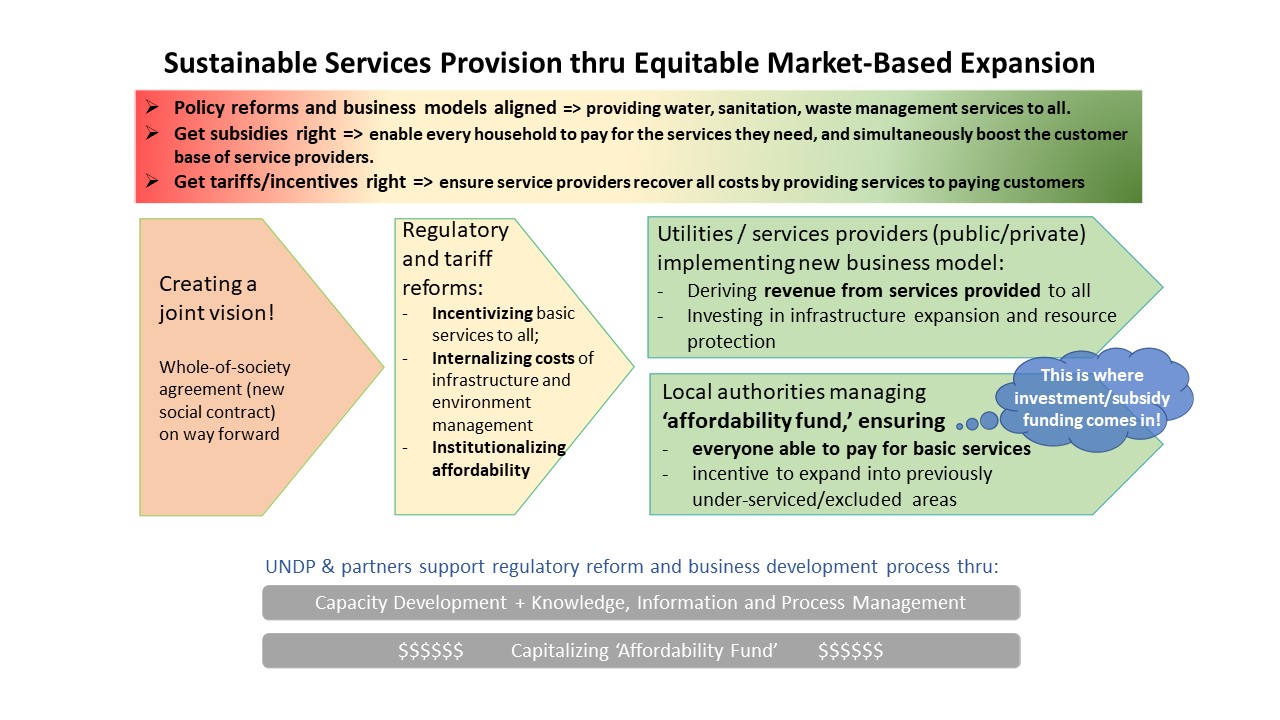Sustainable sanitation for health and dignity
December 17, 2021

Amidst a global pandemic, sanitation is more important than ever. Yet, there is too little priority given to this basic human right, and the conditions under which sanitation services are provided. This blog reflects on the recent World Toilet Day and how to finance sanitation in a more sustainable manner, e.g. by subsidizing services to the most vulnerable, rather than physical infrastructure in general. We need a focus on people, systems, and equity.
Sanitation is fundamental for human health. Readers of the British Medical Journal choose the “sanitary revolution” as the greatest medical advance since 1840 (closely followed by antibiotics, anesthesia and vaccines). Indeed, improved housing and sanitation, rather than treating illnesses, underpinned the formidable transition towards longer and healthier lives in the wealthy nations of today.
Yet, according to WHO/UNICEF, in 2020, 3.6 billion people still did not have safely managed sanitation. Nearly 500 million people resorted to open defecation. Two thirds of the people who lacked even basic services lived in rural areas. Nearly half of them in sub-Saharan Africa. As a consequence, diarrheal disease kills over half a million children every year. The State of the World’s Sanitation suggests that “With only 10 years left until 2030, the rate at which sanitation coverage is increasing will need to quadruple if the world is to achieve the Sustainable Development Goals (SDGs) sanitation targets.”
World Toilet Day observed annually on 19 November reminded us of these dire facts, but also inspired action to end the crisis in sanitation. An event organized by the Permanent Missions of Singapore, India, and Nigeria with UN-Water provided insights into the challenges, efforts and important progress made over the years in those countries.
In the UN-Water discussion panel, FAO emphasized the importance of Circular sanitation economies for more resilient and sustainable food systems. UNDP highlighted the need for recognition and social protection of the sanitation and waste management work force (see report on Health, safety and dignity of sanitation workers by the World Bank, WHO, ILO and WaterAid) and to constructively incorporate formal and informal recycling and reuse endeavours in the transformation towards a circular economy. Other interventions highlighted the importance of innovation, human rights, working with Indigenous peoples, and climate change.
The potential contribution of improved sanitation to both climate change adaptation and mitigation is often neglected and left unfinanced. Expanded and more efficient sanitation and waste management can mitigate climate change by reducing methane emissions from decomposing organic wastes, and by lowering energy use in treatment processes (see Dickens et al on the gaps in global climate policy and financing and forthcoming study by SIWI, UNDP and others, announced in the COP26 event on Water and Mitigation: From Science to Climate Action).
More investment is needed for sanitation. Yet, the largest gap may not necessarily lie in the financing as such, but the failure to translate capital investment into services that are accessible, affordable, and desirable to all. How come people still do not have reliable water and sanitation services even after boreholes, pumps and latrines, or even treatment plants and transmission pipes, have been constructed?
Poor households are often excluded from public services because of unsurmountable connection costs to otherwise underpriced services, or because they live in unplanned areas without formal services. Yet, poor people pay vast amounts for informal services. As suggested in the 2006 Human Development Report “the poor pay more, the rich pay less”. This is inefficient and grossly inequitable.
Working on models for basic services provision, UNDP is exploring ways to make services more environmentally and financially sustainable. The ‘Sustainable Services Provision thru Equitable Market-Based Expansion’ illustration below outlines how an ‘affordability fund’ could transform the urban poor into an important market segment. By subsidizing the households that need support for paying for sanitation and other basic services, affordability will not be an issues when extending services into previously unserved areas.

By subsidizing the service. giving a discount or subsidy to those who need it to be able to pay their bills, rather than the physical infrastructure, we support the long-term sustainability of the system of service provision to all. Service providers would increase revenues and be able to service the loans or finance for investing in requisite infrastructure expansion and environmental management. In many places, perverse incentives, with underpriced services and overpriced connections, entice utilities to defer maintenance and withhold rather than to extend services.)
It is people that make the systems function. Better-performing utilities invest in staff capacity, know the condition of their assets, and are consistently funded by controlling costs and maintaining communication and financial credibility. And, of course, by delivering the services they are mandated to provide; not only to the more privileged, but to all.
Inspired by this year’s World Toilet Day campaign ‘Valuing Toilets’ we recognize also the important contribution of sanitation workers, who bridge the gap between the physical infrastructure and the service provision. This work force, often labouring under undignified and dangerous conditions, merit recognition and respect, health and legal protection, and not least, decent pay. Let us invest in the systems, the services and the people that ensure ‘Safe Sanitation for All’.

 Locations
Locations